tow INFINITI Q50-HYBRID 2014 Owner's Manual
[x] Cancel search | Manufacturer: INFINITI, Model Year: 2014, Model line: Q50-HYBRID, Model: INFINITI Q50-HYBRID 2014Pages: 402, PDF Size: 2.83 MB
Page 302 of 402
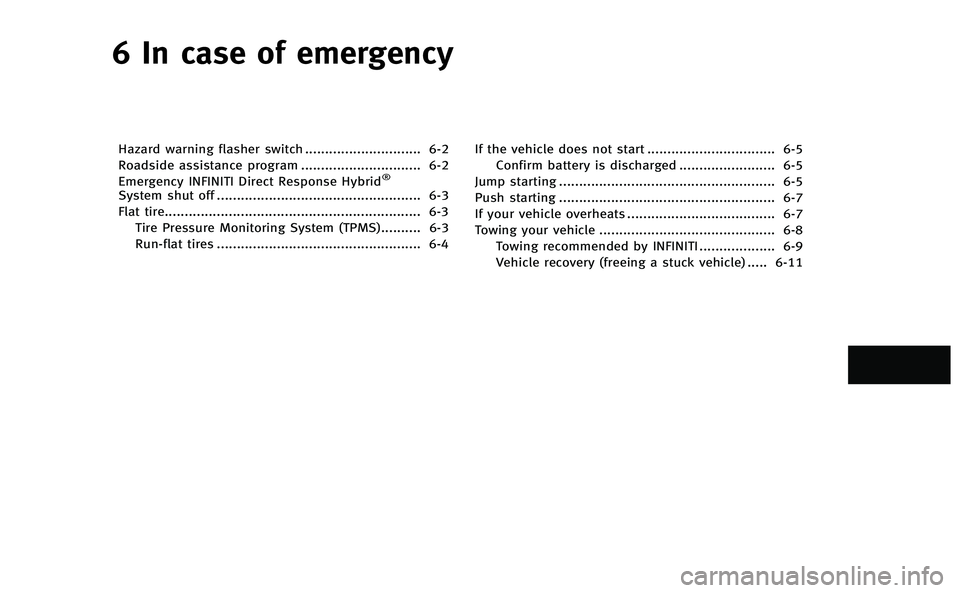
6 In case of emergency
Hazard warning flasher switch............................. 6-2
Roadside assistance program .............................. 6-2
Emergency INFINITI Direct Response Hybrid
®
System shut off ................................................... 6-3
Flat tire................................................................ 6-3 Tire Pressure Monitoring System (TPMS).......... 6-3
Run-flat tires ................................................... 6-4 If the vehicle does not start ................................ 6-5
Confirm battery is discharged ........................ 6-5
Jump starting ...................................................... 6-5
Push starting ...................................................... 6-7
If your vehicle overheats ..................................... 6-7
Towing your vehicle ............................................ 6-8
Towing recommended by INFINITI ................... 6-9
Vehicle recovery (freeing a stuck vehicle) ..... 6-11
Page 308 of 402
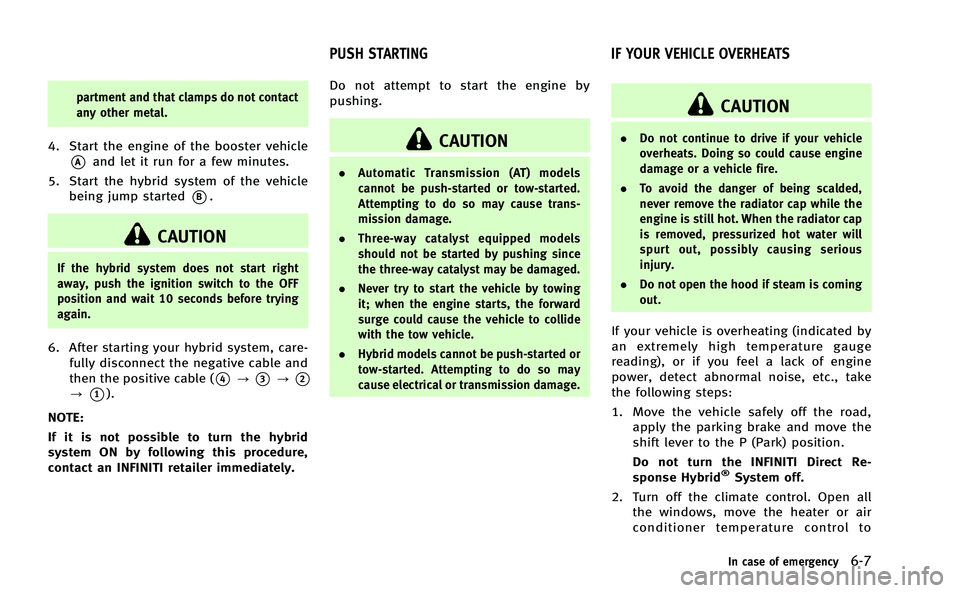
partment and that clamps do not contact
any other metal.
4. Start the engine of the booster vehicle
*Aand let it run for a few minutes.
5. Start the hybrid system of the vehicle being jump started
*B.
CAUTION
If the hybrid system does not start right
away, push the ignition switch to the OFF
position and wait 10 seconds before trying
again.
6. After starting your hybrid system, care-
fully disconnect the negative cable and
then the positive cable (
*4?*3?*2
?*1).
NOTE:
If it is not possible to turn the hybrid
system ON by following this procedure,
contact an INFINITI retailer immediately. Do not attempt to start the engine by
pushing.
CAUTION
.
Automatic Transmission (AT) models
cannot be push-started or tow-started.
Attempting to do so may cause trans-
mission damage.
. Three-way catalyst equipped models
should not be started by pushing since
the three-way catalyst may be damaged.
. Never try to start the vehicle by towing
it; when the engine starts, the forward
surge could cause the vehicle to collide
with the tow vehicle.
. Hybrid models cannot be push-started or
tow-started. Attempting to do so may
cause electrical or transmission damage.
CAUTION
.Do not continue to drive if your vehicle
overheats. Doing so could cause engine
damage or a vehicle fire.
. To avoid the danger of being scalded,
never remove the radiator cap while the
engine is still hot. When the radiator cap
is removed, pressurized hot water will
spurt out, possibly causing serious
injury.
. Do not open the hood if steam is coming
out.
If your vehicle is overheating (indicated by
an extremely high temperature gauge
reading), or if you feel a lack of engine
power, detect abnormal noise, etc., take
the following steps:
1. Move the vehicle safely off the road,
apply the parking brake and move the
shift lever to the P (Park) position.
Do not turn the INFINITI Direct Re-
sponse Hybrid
®System off.
2. Turn off the climate control. Open all the windows, move the heater or air
conditioner temperature control to
In case of emergency6-7
PUSH STARTING IF YOUR VEHICLE OVERHEATS
Page 309 of 402
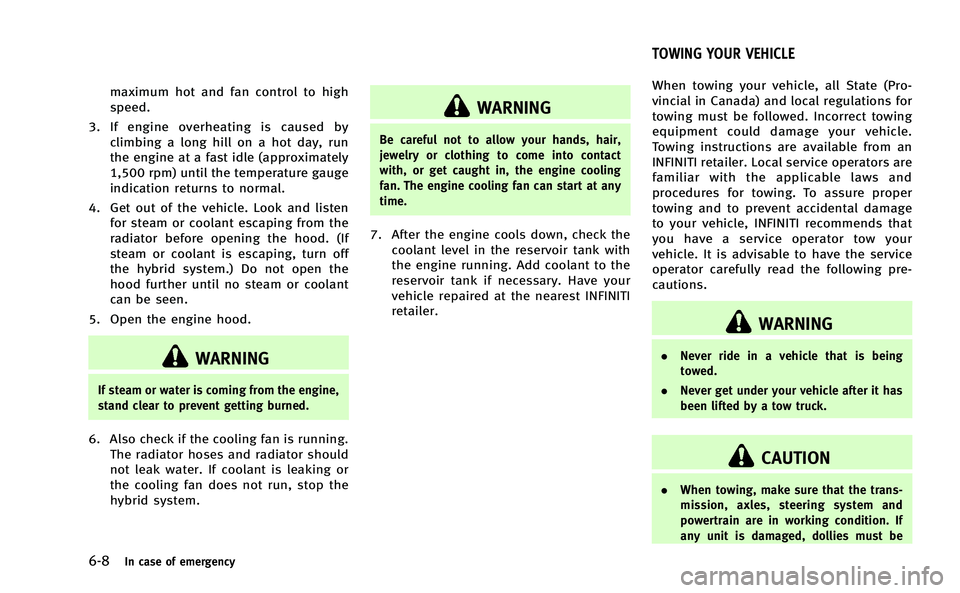
6-8In case of emergency
maximum hot and fan control to high
speed.
3. If engine overheating is caused by climbing a long hill on a hot day, run
the engine at a fast idle (approximately
1,500 rpm) until the temperature gauge
indication returns to normal.
4. Get out of the vehicle. Look and listen for steam or coolant escaping from the
radiator before opening the hood. (If
steam or coolant is escaping, turn off
the hybrid system.) Do not open the
hood further until no steam or coolant
can be seen.
5. Open the engine hood.
WARNING
If steam or water is coming from the engine,
stand clear to prevent getting burned.
6. Also check if the cooling fan is running. The radiator hoses and radiator should
not leak water. If coolant is leaking or
the cooling fan does not run, stop the
hybrid system.
WARNING
Be careful not to allow your hands, hair,
jewelry or clothing to come into contact
with, or get caught in, the engine cooling
fan. The engine cooling fan can start at any
time.
7. After the engine cools down, check thecoolant level in the reservoir tank with
the engine running. Add coolant to the
reservoir tank if necessary. Have your
vehicle repaired at the nearest INFINITI
retailer. When towing your vehicle, all State (Pro-
vincial in Canada) and local regulations for
towing must be followed. Incorrect towing
equipment could damage your vehicle.
Towing instructions are available from an
INFINITI retailer. Local service operators are
familiar with the applicable laws and
procedures for towing. To assure proper
towing and to prevent accidental damage
to your vehicle, INFINITI recommends that
you have a service operator tow your
vehicle. It is advisable to have the service
operator carefully read the following pre-
cautions.
WARNING
.
Never ride in a vehicle that is being
towed.
. Never get under your vehicle after it has
been lifted by a tow truck.
CAUTION
.When towing, make sure that the trans-
mission, axles, steering system and
powertrain are in working condition. If
any unit is damaged, dollies must be
TOWING YOUR VEHICLE
Page 310 of 402
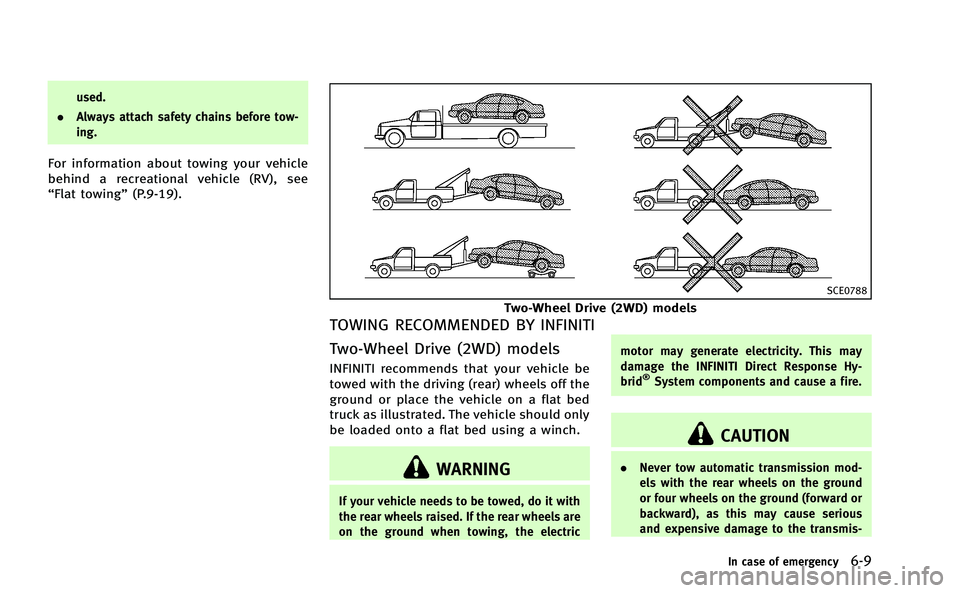
used.
. Always attach safety chains before tow-
ing.
For information about towing your vehicle
behind a recreational vehicle (RV), see
“Flat towing” (P.9-19).
SCE0788
Two-Wheel Drive (2WD) models
TOWING RECOMMENDED BY INFINITI
Two-Wheel Drive (2WD) models
INFINITI recommends that your vehicle be
towed with the driving (rear) wheels off the
ground or place the vehicle on a flat bed
truck as illustrated. The vehicle should only
be loaded onto a flat bed using a winch.
WARNING
If your vehicle needs to be towed, do it with
the rear wheels raised. If the rear wheels are
on the ground when towing, the electric motor may generate electricity. This may
damage the INFINITI Direct Response Hy-
brid
®System components and cause a fire.
CAUTION
.
Never tow automatic transmission mod-
els with the rear wheels on the ground
or four wheels on the ground (forward or
backward), as this may cause serious
and expensive damage to the transmis-
In case of emergency6-9
Page 311 of 402
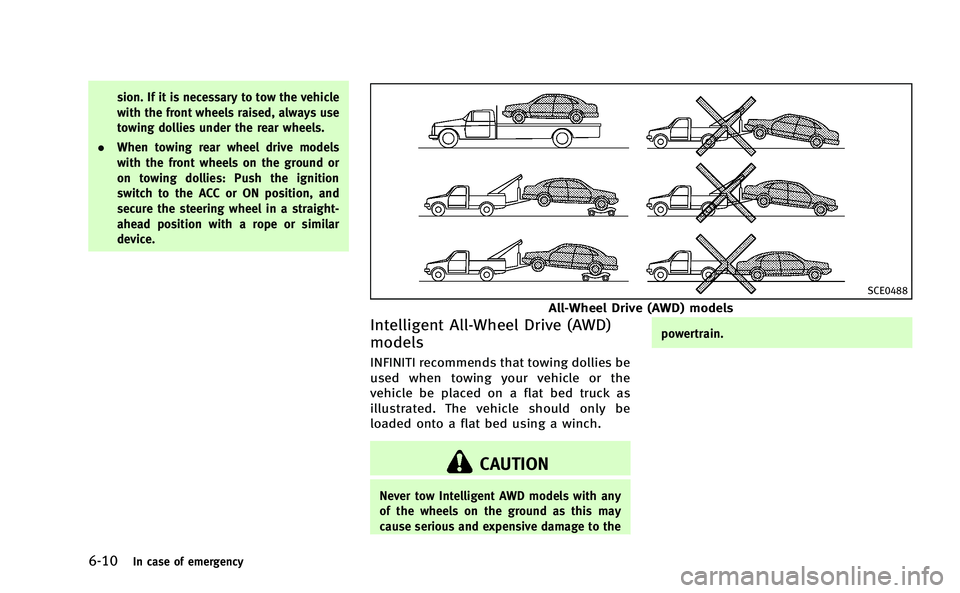
6-10In case of emergency
sion. If it is necessary to tow the vehicle
with the front wheels raised, always use
towing dollies under the rear wheels.
. When towing rear wheel drive models
with the front wheels on the ground or
on towing dollies: Push the ignition
switch to the ACC or ON position, and
secure the steering wheel in a straight-
ahead position with a rope or similar
device.
SCE0488
All-Wheel Drive (AWD) models
Intelligent All-Wheel Drive (AWD)
models
INFINITI recommends that towing dollies be
used when towing your vehicle or the
vehicle be placed on a flat bed truck as
illustrated. The vehicle should only be
loaded onto a flat bed using a winch.
CAUTION
Never tow Intelligent AWD models with any
of the wheels on the ground as this may
cause serious and expensive damage to the powertrain.
Page 312 of 402

JVE0120X
Front
JVE0119X
Rear
JVE0130X
Rear
VEHICLE RECOVERY (freeing a stuck
vehicle)
WARNING
.Stand clear of a stuck vehicle.
. Do not spin your tires at high speed. This
could cause them to explode and result
in serious injury. Parts of your vehicle
could also overheat and be damaged.
Pulling a stuck vehicle
If your vehicle is stuck in sand, snow, mud,
etc., use a tow strap or other device
designed specifically for vehicle recovery.
Always follow the manufacturer’s instruc-
tions for the recovery device.
Front:
1. Remove the cover using a suitable tool.
2. Securely install the vehicle recovery
hook
*1stored in the trunk. Attach the
tow strap to the recovery hook.
Make sure that the hook is properly
secured in the original place after use.
Rear:
Do not use the tie down hook
*2for
towing or vehicle recovery.
The rear hook
*3is designed as the
recovery hook.
To use the recovery hook:
1. Remove the cover from the rear bumper using a suitable tool.
2. Securely install the recovery hook
*3
(stored in the trunk) to the attaching
mount located on the rear bumper.
3. Make sure that the recovery hook is properly secured in its storage location
In case of emergency6-11
Page 313 of 402
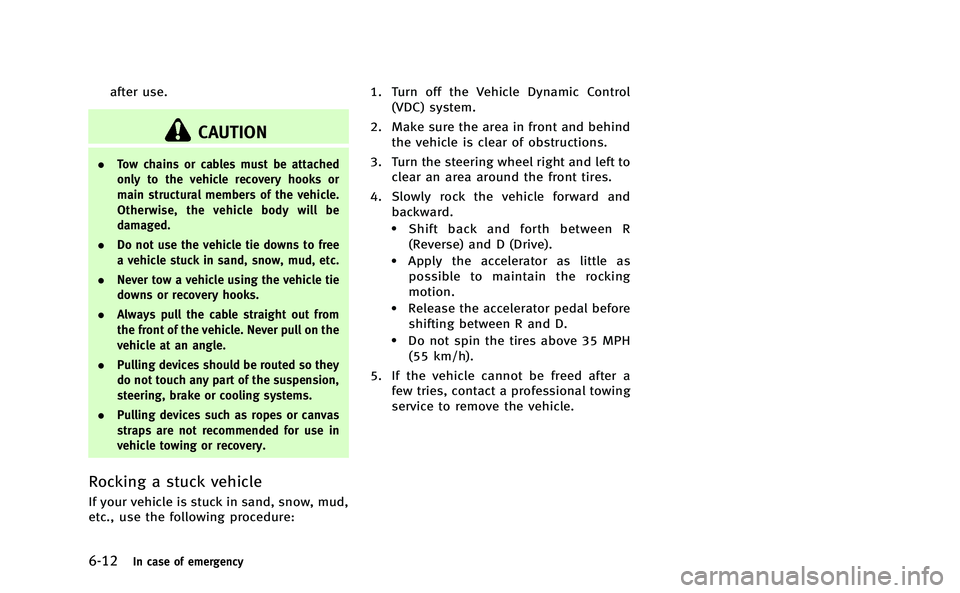
6-12In case of emergency
after use.
CAUTION
.Tow chains or cables must be attached
only to the vehicle recovery hooks or
main structural members of the vehicle.
Otherwise, the vehicle body will be
damaged.
. Do not use the vehicle tie downs to free
a vehicle stuck in sand, snow, mud, etc.
. Never tow a vehicle using the vehicle tie
downs or recovery hooks.
. Always pull the cable straight out from
the front of the vehicle. Never pull on the
vehicle at an angle.
. Pulling devices should be routed so they
do not touch any part of the suspension,
steering, brake or cooling systems.
. Pulling devices such as ropes or canvas
straps are not recommended for use in
vehicle towing or recovery.
Rocking a stuck vehicle
If your vehicle is stuck in sand, snow, mud,
etc., use the following procedure: 1. Turn off the Vehicle Dynamic Control
(VDC) system.
2. Make sure the area in front and behind the vehicle is clear of obstructions.
3. Turn the steering wheel right and left to clear an area around the front tires.
4. Slowly rock the vehicle forward and backward.
.Shift back and forth between R
(Reverse) and D (Drive).
.Apply the accelerator as little as
possible to maintain the rocking
motion.
.Release the accelerator pedal beforeshifting between R and D.
.Do not spin the tires above 35 MPH(55 km/h).
5. If the vehicle cannot be freed after a few tries, contact a professional towing
service to remove the vehicle.
Page 317 of 402

7-4Appearance and care
ambient temperature.
. Rinse the wheel to completely remove
the cleaner within 15 minutes after the
cleaner is applied.
Bright wheels (if so equipped)
The bright wheels use a different coating
process than typical aluminum alloy wheel
and they are not plated wheels. These
wheels are clear-coated and require the
following special cleaning. They should be
regularly washed with a soft sponge
soaked in a lot of water. After washing
with water, wipe clean with a dry, soft cloth
and dry completely. When there is chemical
or tire wax, or dirt such as an antifreeze
agent on the surface, wash them with
water as soon as possible.
CAUTION
.The surfaces of the wheels use a
different coating process than typical
aluminum alloy wheels. Do not use
aluminum alloy wheel cleaners or abra-
sive cleaners to clean the wheels. Using
such cleaners could damage the wheel
surfaces. .
Do not use an automatic car wash if the
vehicle is equipped with bright wheels.
The wheel coating may be damaged.
. Do not use a brush to wash the wheels if
the vehicle is equipped with bright
wheels. The wheel coating may be
damaged.
CHROME PARTS
Clean chrome parts regularly with a non-
abrasive chrome polish to maintain the
finish.
TIRE DRESSING
INFINITI does not recommend the use of
tire dressings. Tire manufacturers apply a
coating to the tires to help reduce dis-
coloration of the rubber. If a tire dressing is
applied to the tires, it may react with the
coating and form a compound. This com-
pound may come off the tire while driving
and stain the vehicle paint.
If you choose to use a tire dressing, take
the following precautions:
.Use a water-based tire dressing. The
coating on the tire dissolves more
easily with an oil-based tire dressing. .
Apply a light coat of tire dressing to
help prevent it from entering the tire
tread/grooves (where it would be diffi-
cult to remove).
. Wipe off excess tire dressing using a
dry towel. Make sure the tire dressing
is completely removed from the tire
tread/grooves.
. Allow the tire dressing to dry as
recommended by tire dressing manu-
facturer.
Page 318 of 402

Occasionally remove loose dust from the
interior trim, plastic parts and seats using
a vacuum cleaner or soft bristled brush.
Wipe the vinyl and leather surfaces with a
clean, soft cloth dampened in mild soap
solution, then wipe clean with a dry soft
cloth.
Regular care and cleaning is required in
order to maintain the appearance of the
leather.
Before using any fabric protector, read the
manufacturer’s recommendations. Some
fabric protectors contain chemicals that
may stain or bleach the seat material.
Use a cloth dampened only with water, to
clean the meter and gauge lens.
WARNING
Do not use water or acidic cleaners (hot
steam cleaners) on the seat. This can
damage the seat or occupant classification
sensors. This can also affect the operation
of the air bag system and result in serious
personal injury.
CAUTION
. Never use benzine, thinner, or any
similar material.
. For cleaning, use a soft cloth, dampened
with water. Never use a rough cloth,
alcohol, benzine, thinner or any kind of
solvent or paper towel with a chemical
cleaning agent. They will scratch or
cause discoloration to the lens.
. Do not spray any liquid such as water on
the meter lens. Spraying liquid may
cause the system to malfunction.
. Small dirt particles can be abrasive and
damaging to the leather surfaces and
should be removed promptly. Do not use
saddle soap, car waxes, polishes, oils,
cleaning fluids, solvents, detergents or
ammonia-based cleaners as they may
damage the leather’s natural finish.
. Do not clean the interior or trunk using
water. If water contacts the Lithium-ion
(Li-ion) battery, it may cause a short
circuit and damage the battery.
. Only use fabric protectors approved by
INFINITI. .
Do not use glass or plastic cleaner on
meter or gauge lens covers. It may
damage the lens cover.
Appearance and care7-5
CLEANING INTERIOR
Page 368 of 402

9 Technical and consumer information
Capacities and recommended fuel/lubricants....... 9-2
Fuel information .............................................. 9-4
Engine oil and oil filter recommendation ......... 9-6
Air conditioning system refrigerant and
lubricant recommendations ............................. 9-7
Specifications ...................................................... 9-8
Engine............................................................. 9-8
Wheels and tires ............................................. 9-9
Dimensions ................................................... 9-10
When traveling or registering your vehicle in
another country ................................................. 9-11
Vehicle identification ......................................... 9-11 Vehicle Identification Number (VIN) plate ....... 9-11
Vehicle identification number
(chassis number) ........................................... 9-11
Engine serial number .................................... 9-12
F.M.V.S.S./C.M.V.S.S. certification label .......... 9-12
Emission control information label ................ 9-12
Tire and loading information label ................. 9-13
Air conditioner specification label.................. 9-13 Installing front license plate .............................. 9-14
Removing air deflectors..................................... 9-15
Vehicle loading information............................... 9-16
Terms .......................................................... 9-16
Vehicle load capacity ................................... 9-17
Loading tips................................................. 9-18
Measurement of weights.............................. 9-18
Towing a trailer ................................................. 9-19 Flat towing................................................... 9-19
Uniform tire quality grading .............................. 9-19
Treadwear .................................................... 9-19
Traction AA, A, B and C................................ 9-20
Temperature A, B and C ............................... 9-20
Emission control system warranty ..................... 9-20
Reporting safety defects.................................... 9-21
Readiness for Inspection/Maintenance (I/M) test
(US only)........................................................... 9-22
Event Data Recorders (EDR) ............................... 9-23
Owner’s Manual/Service Manual
order information .............................................. 9-23